Posted by Elena del Valle on May 1, 2014
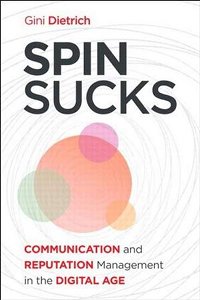
Spin Sucks
Photos: Arment Dietrich, Inc.
Communicating responsibly, honestly, openly and authentically rather than by “spinning” is the best long term approach to public relations, says Gini Dietrich, chief executive officer, Arment Dietrich, a marketing and communications company. In Spin Sucks: Communication and Reputation Management in the Digital Age (Que, $19.99), a 154-page softcover book published this year, she explains the reasons she advocates such a communication approach. Prior to this book, she co-authored Marketing in the Round with Geoff Livingston in 2012.
”
Spin Sucks is targeted toward business leaders who hire PR firms or communicators for their internal teams. Many business leaders understand they need PR, they know – instinctively – if it’s working, but they don’t really understand how it works. This book is meant to help them understand what we do, how to hold their teams accountable, and what kinds of metrics they can expect. That said, most of the readers so far are communicators,” the author said by email in reply to a question about the target audience and the reason she wrote her book. “I wrote Spin Sucks because there is a really bad perception people have about our industry. We are not liars or spin doctors. The big, big vision is to change the perception.”
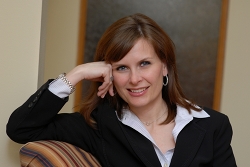
Gini Dietrich, author, Spin Sucks
The book is divided into ten chapters and four sections: Tell Your Story Without Sex or Extortion; Scammers, Liars and Beggars; Your Brand; Your Customers; and Spin Sucks. A brand is controlled by customers in the outside world, she says in the book. Customers have a voice and they are not afraid to use it.
”
This is a marathon, not a sprint. Lots of business leaders think they can hire a PR firm and 90 days later, they’re famous and on every cover of every media outlet and their product or service is sold out. It doesn’t matter if you’re doing media relations, social media, content, lead generation, reputation management, or advertising, it takes time. Just like you can’t go out and run 26.2 miles without training, you have to prepare for success over a long period,” she said. “The very best thing you can do is always be ethical in how you handle yourself. Don’t take shortcuts. Don’t cheat. Don’t lie.”
In the last section, the author turns her attention toward the future speculating that communications will play a bigger role in customer service. She says it is essential to understand how customers want to interact with brands.
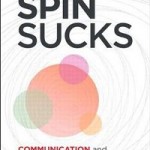
Click to buy Spin Sucks
Comments:
Filed Under: Books
Posted by Elena del Valle on April 11, 2014
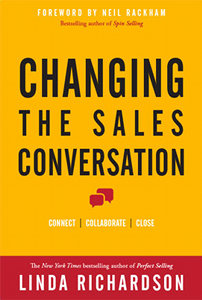
Changing the Sales Conversation
Photos: Sharon Wolmuth
As the market has shifted with social media and technological advances so have consumers. Selling requires a new approach and an increased awareness of client needs and likes, according to some experts. In Changing the Sales Conversation: Connect, Collaborate, and Close (McGraw Hill, $22) Linda Richardson, founder, Richardson, a sales performance company, discusses the issues she considers relevant to the changing sales environment for a target audience of salespeople and sales managers primarily in business to business sales.
”
I introduced Consultative Selling several decades ago and while the tenants of Consultative Selling remain relevant, buyers’ buying habits have dramatically changed and I wrote Changing the Sales Conversation to extend the concepts of
Consultative Selling to foster a new dynamic dialogue for the new sales landscape. The internet and emerging technologies have changed the face of selling so much so that many of the tried and true sales methodologies of just a short time ago are obsolete and some can actually hurt sales,” she said by email in response to a question on why she wrote a book about sales.
The 162-page hardcover book was published this year. It is divided into: Introduction, Futuring: Meta-Preparation, Heat-Mapping: Anticipating Client Need, Value-Tracking: Shaping Solutions, Phasing: Controlling the Process, Linking: Connecting Emotionally, and Opening into the Future. The author explained she wrote it to provide insight into the changes and give models and tools to help salespeople and sales managers succeed in the new world of selling.
”
The key to selling to customers today is to insure that they have a higher level of expertise and skill and having access to resources, research, and tools. Salespeople must have industry, company, and stakeholder knowledge and use tools and research to understand the individuals they are selling to including their cultures and values. I cover this in the chapter on Futuring which is a higher level of preparation. Sales organizations must support salespeople with knowledge sharing, training, and tools,” Richardson said in reply to a question about dealing with diversity in an increasingly global marketplace when trying to build trust.
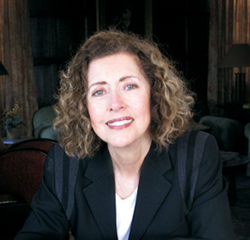
Linda Richardson, author, Changing the Sales Conversation
“One of the key challenges is to get ahead of the opportunity by brin(g)ing ideas to customers. It is important for salespeople to understand what their clients already know because clients are doing research, using social media, and turning to peers and can be half way through the buying cycle before talking to a salesperson. The real challenge I see is having the knowledge and insight to bring ideas to clients rather than get involved late in the sale when the client is advanced and be in heavy competition,” she said in response to a question about the biggest challenge in getting to know a client in today’s environment.
The consultant believes clients expect sales people to be prepared and informed. In the book, she explains that clients are able to tell quickly whether a salesperson is able to create value for them, and that by being informed about a client’s industry, company and stakeholders a salesperson will be competitive. Using tools such as social media, paying attention to their client’s trusted sources and listening to clients to learn about their needs and environment can be important in increasing productivity; and preparing in advance is necessary to succeed, she says.
Richardson teaches sales and management at the Wharton Graduate School of the University of Pennsylvania and the Wharton Executive Development Center. Her previous book, Perfect Selling, was a The New York Times bestseller.
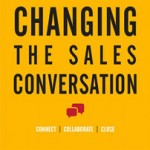
Click to buy Changing the Sales Conversation
Comments:
Filed Under: Books
Posted by Elena del Valle on March 28, 2014
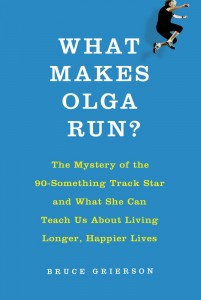
What Makes Olga Run
Photos: Jennifer Williams, Henry Holt and Company
Geriatric runners have become a common site in urban marathons but ninety year old sprinters are exceptional, says Bruce Grierson. In What Makes Olga Run The Mystery of the 90-Something Track Star and What She Can Teach Us About Living Longer, Happier Lives (Henry Holt and Company, $25), the author explores what makes Olga Kotelko, a 91 year old sprinter who held 26 world records in 2009, exceptional.
At five feet and half an inch tall and weighing 130 pounds she is, he explains, extraordinarily strong. As of the publication of the book this year she was the holder of 600 medals.
“I think two types of readers are in the sweet spot:
The first are people who’ve been lifelong exercisers who are now suddenly burning out or breaking down or both. Having to figure out how to mix things up so as to mitigate the damage and rekindle the interest.
The second group is middle-aged couch potatoes. Their takeaway message is that it’s never too late,” he said by email in response to a question about the target audience for the book. “The science is telling us that you can make massive gains even deep into life. The trick is to get started. It’s hard to start. Olga says that a lot: ‘Don’t stop, cuz it’s hard to get started again.'”
The 231-page softcover book is divided into Prologue, Coda and 12 chapters. In addition to Kotelko, Grierson interviewed dozens of masters athletes and closes the book with nine tips for readers who want to emulate the high performing older athletes.
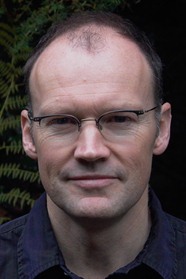
Bruce Grierson, author, What Makes Olga Run?
When asked what the hardest part of the book project was he said: “Getting the running shorts over my pot belly. No, seriously, the difficult part was trying to run a narrative through the all the science without getting bogged down in detail but still getting the facts right. The physiology of aging is a fascinating area that’s changing almost by the day. A challenge to stay on top of.”
The most rewarding or surprising aspect? “Getting to know Olga as a person, not just as a scientific anomaly or a story ‘subject.’ We spent a lot of time together. It helped that we were simpatico. She’s taught me a lot, and most of it has nothing to do with ‘fitness,’ per se.”
Asked if there was third party funding or sponsorships for the book project he said: ”
No. The scientists involved did the testing for free. In McGill’s case, the scientists specifically got their own funding to conduct the muscle physiology tests on Olga, as part of an ongoing investigation on aging athletes. The small stuff I paid for. Olga got the guinea pig’s discount (i.e. free).”
Grierson, a freelance writer, is author of U-Turn: What If You Woke Up One Morning and Realized You Were Living the Wrong Life? He lives in North Vancouver, Canada.
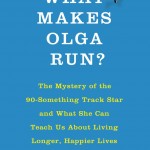
Click to buy What Makes Olga Run?
Comments:
Filed Under: Books
Posted by Elena del Valle on March 14, 2014
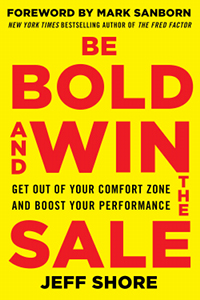
Be Bold and Win the Sale
Photos: McGraw Hill, Jeff Shore
Taking action despite fear and discomfort without being manipulative or obnoxious when others would back away is what Jeff Shore advises when it comes to sales. In Be Bold and Win the Sale Get Out of Your Comfort Zone and Boost Your Performance (McGraw Hill, $20) he emphasizes that winning should reward all parties involved, and that a sale is about helping customers improve their lives.
At the end of the chapters, he features Expert Interviews in which he illustrates the point of that chapter with feedback or quotes from someone he considers an expert. For example, in the chapter on discomfort he quotes Daniel Pink, author of Drive: The Surprising Truth About What Motivates Us. Pink points to a study from the University of Pennsylvania that suggests the best sales people are neither completely introverted nor extroverted but rather in the middle of the spectrum.
He also recommends finding experts who stand out when it comes to picking up and understanding the perspectives of others. Serving, by improving someone’s life, Pink believes, is lacking the most in today’s sales world.
The 261-page softcover book published this year is divided into three parts and 15 chapters. Part One, Dealing with Discomfort, features: “Well, This is Awkward,” Getting Your Inner Boldness On, That Nagging Squirminess, Story Time, and The Gut Check.
Part Two, Developing Boldness, features: Let’s Do This Thing!, The Boldness Network, Retraining Your Brain, Big Problems in Little Packages, Handling the “Gotchas,” The Advanced Course, and Go! Part Three, Putting It All to Work, features: The Customer’s Mission, The Customer’s Mission, The Customer’s Mission, and Putting It All Together.

Jeff Shore, author, Be Bold and Win the Sale
Shore, founder and president, Shore Consulting, Inc., is fellow of the National Speakers Association’s Million Dollar Roundtable.
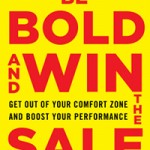
Click to buy Be Bold and Win the Sale
Comments:
Filed Under: Books
Posted by Elena del Valle on February 28, 2014
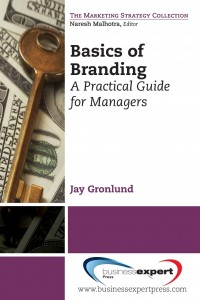
Basics of Branding
Photos: The Pathfinder Group
Not all brands are created equally. Some pass unnoticed and fade into oblivion while others linger in our minds for years or longer. What makes the difference? Powerful brands are different, compelling, and relevant enough to truly excite the minds and hearts — and wallets — of their customers. That is what Jay Gronlund, a business development consultant, believes. In his new book Basics of Branding: A Practical Guide for Managers (Business Expert Press, $43.95) he explains how readers can create an emotional connection with their customers that results in sustainable brand loyalty and steady revenue growth. The book is also available in digital format for $19.95.
“Yes, definitely. The principles behind branding are relevant for all types of businesses, big or small, product or service,” Gronlund said by email in response to a question about the relevance of branding regardless of size of the company. “Brand positioning starts with defining and thoroughly understanding your target customer. Most start-ups are preoccupied with their new product or service, and don’t pay enough attention to addressing what their potential customers want, especially from an emotional standpoint. Branding is basically about creating a relationship with a customer, and it has been proven by neuroscientists that emotions have the most influence on human behavior, including purchase decisions.”
The 194-page softcover book with tables and illustrations published in 2013 is divided into six chapters: What Is Branding Really About?; The Positioning Statement, Emotions and Brand Equity; Branding Applications; Building Strong Bonds; Branding in the B2B World, New Opportunities; Marketing Today: Branding for Digital Marketing and Social Media. Gronlund proposes that it is critical to begin with a “message or impression that forges a bond of trust with that customer.”
One thing to remember about branding? “Branding is all about forming a connection with your customer, ideally one based on experience and emotions that make that customer trust that brand,” he said by email.
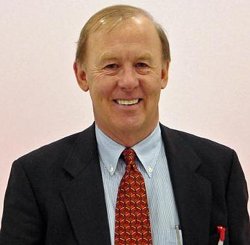
Jay Gronlund, author, Basics of Branding
When asked about developing a brand for an intangible such as an author he said: “A service, while not as concrete as a product, still requires good branding, since both must make a promise (i.e. the benefit) to a target audience, supported by credible reasons to believe this promise. Ultimately, a customer will become interested in a service, and buy it, only if they feel emotionally (and rationally) that such a service will add some value to their lives and make them more happy and satisfied. Any author, for fiction or non-fiction, should try to brand him or herself, so that the author’s (brand) name will mean something special to prospective readers. Ideally building a bond with his/her audience is based on trust, plus the expectation that each time he/she will learn and/or be entertained. The brand impression the author provides should be distinct, relevant and tailored to the unique characteristics of his/her storytelling, content/subject matter, and flair for offering something new and creative.”
Gronlund has held senior positions at Richardson-Vicks, Church & Dwight, Seagrams, and Newsweek. In 1990, he started The Pathfinder Group, a boutique business development consulting firm specializing in cross-border marketing; re-positioning brands; facilitating ideation sessions; and con- ducting workshops overseas. In 1999, he created a course on positioning and brand development for New York University he still teaches today.
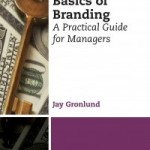
Click to buy Basics of Branding
Comments:
Filed Under: Books
Posted by Elena del Valle on February 7, 2014

Peruvian Power Foods
Photos: Health Communications, Inc.
Manuel Villacorta, MS, RD, CSSD dedicated two years to researching particularly nutritious foods, traveling to his native Peru to connect with chefs, farmers, food bloggers, fishermen, and people in general about that country’s indigenous foods. As part from his journey of discovery the dietician with 16 years of experience created 100 recipes and took 2,000 photos many of which are featured in Peruvian Power Foods: 18 Superfoods, 101 Recipes, and Anti-aging Secrets from the Amazon to the Andes (Health Communications, Inc. $18.95), a 310-page paperback book he wrote with the help of coauthor Jamie Shaw, a writer, branding specialist and recipe creator. The recipe examples include breakfast granola with lucuma, white bean hummus with sacha inchi, pichuberry muffins, maca shake, and truffles with cacao and camu camu.
“The reception has been great. Peruvian cuisine is a hot topic at the moment,” Villacorta said by email in response to a question about the public acceptance to his new book published October 2013. “Chefs are heralding the cuisine with the enthusiasm they once reserved for France. Peruvian restaurants are popping up in major cities everywhere. On his Parts Unknown program, Anthony Bourdain dubbed Peru’s cuisine one of the most underrated in the world. Clearly, something was happening in my home country. And while it’s partially due to the innovative preparations and exciting cross-cultural dishes being developed, Peru is also home to thousands of foods found nowhere else on the planet, many of which are staggering in their content of potent nutrients. As a native Peruvian, I felt there was no better time than the present to share my knowledge about the foods that originate from the region. And as a registered dietitian, I was interested in the health properties of these foods. This book helped me marry the two, health and cooking.”

Manuel Villacorta, MS, author, Peruvian Power Foods
The book highlights 18 foods believed to be particularly high in nutrient value. They are pichuberry, maca, cacao, kiwicha, avocado, aji, camu camu, purple corn, artichokes, sacha inchi, lucuma, beans, purple potatoes, cilantro, papaya, yacon, quinoa, and sweet potatoes. Each food section features nutritional aspects, culinary uses, and recipes.
“Yes. Moreover, I’m especially finding the Latino population to be very receptive, and have been asked on many occasions, if the book will be translated into Spanish,” the nutritionist said when asked about the popularity of the book among immigrant families.
While some like artichokes, cilantro, sweet potatoes, beans and avocado are easy to find many others are not prevalent in supermarkets. Fresh pichuberries, for example, seem particularly challenging to find. In Appendix B and by email in response to a question about how to purchase the ingredients for the recipes he said: “Latino markets and/or regular supermarkets like Whole Foods, Trader Joe’s, Safeway, and Vons. Brands used in the book were Sacha Vida, Navitas, Barry Farm, and Bobs Red Mill.”
Villacorta is also author of Eating Free: The Carb-Friendly Way to Lose Inches, Embrace Your Hunger, and Keep the Weight off for Good. He served as a national media spokesperson for the Academy of Nutrition and Dietetics. He is a health blog contributor to The Huffington Post, an on-air contributor to Univision, and a health and lifestyle contributor for Fox News Latino. He owns a San Francisco-based private practice.

Click to buy Peruvian Power Foods
Comments:
Filed Under: Books
Posted by Elena del Valle on January 8, 2014
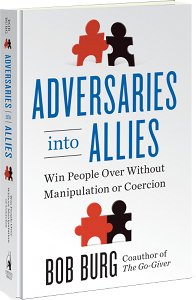
Adversaries into Allies
Photos: Bob Burg
Bob Burg believes that being successful in life and in business is the result of having technical and people skills. Ninety percent of the success comes from people skills and only ten percent from technical skills, according to him. He says that there are many highly talented people in the world who only achieve average results because they lack good people skills.
In Adversaries into Allies: Win People Over Without Manipulation or Coercion (Portfolio, $26.95), published in 2013, Burg explores the path to influence by converting adversaries into partners. It’s his opinion that persuasion need not be about winners and losers. He proposes an approach that results in mutual benefit rather than one that leaves the other person feeling taken advantage of which in turn might produce resistance and a negative attitude.
The 250-page hardcover book is divided into 76 chapters and six main sections: The Five Principles of Ultimate Influence, Control Your Own Emotions, Understand the Clash of Belief Systems, Acknowledge Their Ego, Set the Proper Frame, Communicate with Tact and Empathy, and The Character of Ultimate Influencers.

Bob Burg, author, Adversaries into Allies
He defines Ultimate Influence as the ability to get the results you want from others while making them feel genuinely good about themselves, the process, and about you. One of the ways to do that, he says, is for people to control their own emotions. Such control allows them to help their adversaries be open to the ideas they propose. He stresses that to avoid confusion it’s important to understand that we all follow an unconscious set of beliefs based on experiences and ideas which vary from one person to another.
Helping people feel good about themselves helps the influencer make an ally, according to Burg. Approaching a conflict from a position of benevolence, resolution, and helpfulness increases the likelihood that an adversary will follow the influercer’s lead; and communicating with tact and empathy at the right time can go a long way to win someone over, he says.
Burg is coauthor of The Go-Giver, Go Givers Sell More, and It’s Not About You, and the author of Endless Referrals. According to promotional materials, The Go-Giver was a BusinessWeek and The Wall Street Journal bestseller and has been translated into twenty languages. Together, his books have sold more than a million copies. A speaker, Burg presents to corporations and associations internationally, including Fortune 500 companies, franchises and direct sales organizations.

Click to buy Adversaries into Allies
Comments:
Filed Under: Books
Posted by Elena del Valle on December 20, 2013
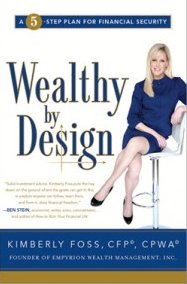
Wealthy by Design
Photo: Kimberly Foss
Kimberly Foss, CFP, CPWA, rose from a home with “financially challenged parents” to become the president and founder of Empyrion Wealth Management, which according to promotional materials, was named one of the nation’s top wealth managers by Bloomberg’s Wealth Manager Magazine. In Wealthy by Design (Greenleaf Book Group Press ebook), published June 2013, she shares some of her life story and wealth management ideas. She assumes readers will rely on a financial planner who will work with them based on their goals, risk taking preferences, equity and age.
She explains that there are two primary types of financial advising services, consultative and transactional. The former focus on client goals and needs and charge based on the number of assets they manage for a given client while the latter recommend products for which they earn commissions. In Appendix A, she provides readers questions to ask a prospective adviser. In Appendix B, she offers six allocation strategies for portfolios. In the ebook edition, it was challenging to read the graphics as displayed on the tablet reader.
In her book, she outlines the importance of understanding personal financial drivers before making long term investment decisions. She strives to demonstrate to readers how following five foundational principles of investing can lead to wealth management based on individual goals and circumstances. The principals are: Goal Setting, Planning, Commitment, Assessment, and Flexibility. The book is divided into an Introduction, a chapter each for the principles, and a Conclusion as well as two appendices. She relies on case studies and anecdotes to illustrate her points. For example, she describes a risk averse client for whom she organized, thanks to her banking relationships, a 15-year CD.
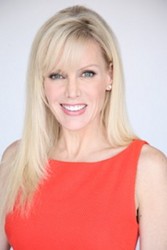
Kimberly Foss, author, Wealthy by Design
She touts the importance of focusing on the best interests of clients, the relationship between asset allocation strategy and the success of a portfolio, and portfolio diversification. An investor’s approach to building wealth, she says in the Conclusion, should be considered with care, planned, reviewed and never random.
Foss has 26 years of financial services experience. She is a member of the Investment Management Consultants Association.
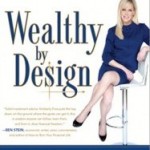
Click to buy Wealthy by Design
Comments:
Filed Under: Books
Posted by Elena del Valle on November 15, 2013
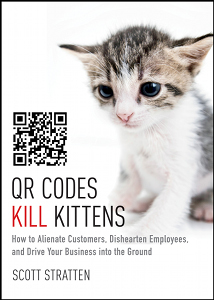
QR Codes Kill Kittens
Photos: Wiley
A quick response code or QR code for short is a type of bar code that requires a smart phone and an app to read it. According to Wikipedia, it is a kind of two-dimensional barcode that can be read optically by a machine. It is used to read information. If the app is able to read the QR code it was made correctly. Once the app reads the code it should lead the user to a mobile device friendly link or website.
QR codes have become common marketing tools, appearing on products, billboards, bus stops and so forth. The problem, according to Scott Stratten, president of UnMarketing, is that most QR codes don’t work. He believes it is because many people are too focused on using codes without paying enough attention to functionality. He proposes that if it mattered people would make sure they worked when they launch them.

Scott Stratten, author, QR Codes Kill Kittens
“If you knew that your terrible business decisions could cost a kitten its life, would you still do it? Of course not. No one wants to hurt a kitten, and no one wants to damage their own business through easily avoidable mistakes. The trick is, knowing which things are the wrong things to do,” Stratten said.
To make his point he wrote QR Codes Kill Kittens: How to Alienate Customers, Dishearten Employees, and Drive Your Business into the Ground (Wiley, $18), a 196-page hardcover small book focused on what goes wrong when QR codes don’t work.
The four color book is easy to read and often humorous. It includes photos on almost every page. It is divided into four sections designed to showcase why QR codes represent what’s wrong with business today including; They Don’t Work, Nobody Likes Them, They are Selfish and They Take Up Valuable Time Better Spent Elsewhere. Stratten, ranked among the top online influencers by Forbes.com, is also author of Unmarketing.
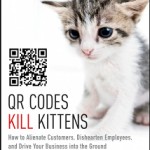
Click to buy QR Codes Kill Kittens
Comments:
Filed Under: Books
Posted by Elena del Valle on November 8, 2013
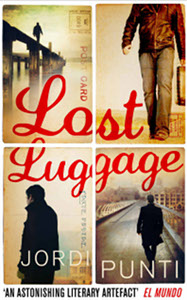
Lost Luggage
Photos: Atria Books / Marble Arch Press
Jordi Punti, a writer and translator, and a contributor to the Spanish and Catalan press, was rewarded with recognition when he released his first novel. Lost Luggage (Atria Books / Marble Arch Press, $16), published in English in paperback and e-book editions in October 2013, was translated into 15 languages, and won the Spanish National Critics’ and the Catalan Booksellers prizes. Prior to this title Punti published three books of shorts stories.
In the 440-page book, Cristofol, a young Barcelona resident, is informed by the police that his father’s flat has been abandoned and its owner is missing. The man who vanished, a truck driver, left Cristofol and his mother 20 years earlier. At the apartment he had never heard about Cristofol finds a list of names belonging to his half brothers Christof, Christophe, and Christopher. He contacts them. None of them was aware that he had half siblings from a common father. None of them had seen his father in many years.

Jordi Punti, author, Lost Luggage
Although they live in different European cities they decide to meet for the first time. They wonder why he abandoned them and why they have similar names. In their journey to find the answers they discover a man who during 30 years of driving was able to escape the darkness of Spain under its former president Francisco Franco and to explore Europe.
Since he received a degree in Romance Philology in 1991, Punti has worked in Barcelona publishing houses, and co-directed La Flor Inversa (The Inverse Flower), a collection of medieval poetry along with Jordi Cerdà and Eduard Vilella, according to lletra.net.

Click to buy Lost Luggage
Comments:
Filed Under: Books







































